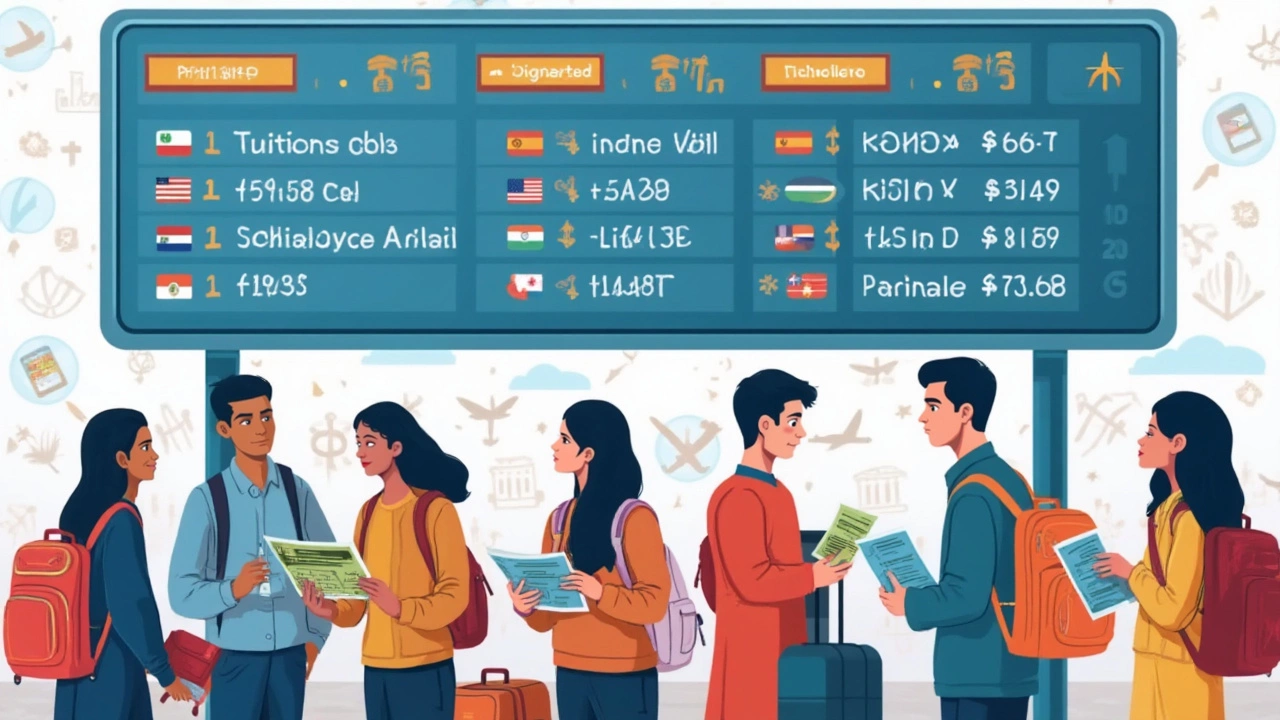The first question that hits most people: Do I have enough money to even start planning to study abroad? You can scroll through shiny brochures and Instagram feeds, but the real costs can make your head spin if you're not prepared.
Tuition fees alone can range from a few thousand to tens of thousands of dollars a year, depending on the country and the course. But that’s just the kickoff—there’s visas, insurance, flights, rent, daily meals, textbooks, and way more. Miss one detail, and you could end up scrambling for cash halfway through the semester.
Don’t buy into the myth that Europe is always cheaper or that you’ll automatically save money in Asia. The differences are wild, even city to city in the same country. For example, studying in Berlin can cost way less than living in London, but both have unexpected charges that don’t show up in the official guides.
Got your heart set on scholarships or part-time jobs to fund you? Those help, but the rules can be tricky—some countries barely let you work, while others offer lots of options. Getting the real numbers before you leave home is what keeps you from getting stuck or calling home for emergency cash transfers.
- Tuition and Application Fees: The First Big Chunk
- Living Expenses: What Everyday Life Really Costs
- Hidden and Unexpected Costs You Didn't Plan For
- Ways to Save: Scholarships, Jobs, and Budgeting Hacks
Tuition and Application Fees: The First Big Chunk
This is where the biggest share of your budget goes. Tuition fees for international students can feel like a punch in the gut if you don’t check ahead. The difference between studying medicine in the UK and engineering in Germany isn’t just the subject—it’s the price tag.
Here’s a quick look at average annual tuition costs as of 2025 in some popular study destinations:
| Country | Public University | Private University |
|---|---|---|
| USA | $10,000 - $35,000 | $35,000 - $60,000 |
| UK | $12,000 - $30,000 | $18,000 - $45,000 |
| Canada | $9,000 - $25,000 | $20,000 - $40,000 |
| Australia | $12,000 - $28,000 | $20,000 - $43,000 |
| Germany | Mostly Free - $1,500 | $8,000 - $25,000 |
| Japan | $5,000 - $8,000 | $10,000 - $28,000 |
Application fees can throw you off if you don’t count them in. Most schools charge $50 to $150 per application, and some places (looking at you, US grad schools) actually make you pay for sending test scores too.
Don’t forget there are often admin fees, technology fees, and extra charges for labs or special courses. These can sneak up to several hundred dollars per year, depending on the university and your program. If you’re eyeing courses like medicine or business, prepare for even higher fees.
Here's a tip: Germany and some Nordic countries offer almost free tuition for international students at public universities, but you still have to prove you can cover living costs. On the flip side, countries like the USA, UK, and Australia crank up the price, especially for private schools and specialist degrees.
- Always check if tuition is fixed for your whole degree or if it increases each year.
- Check if you’ll need to put down a deposit to secure your place—that usually isn’t refundable.
- Ask if there are fee waivers or discounts for early or group applications.
Your study abroad cost starts stacking up from the day you hit ‘Submit’ on your first application, so check the numbers before making any sudden moves.
Living Expenses: What Everyday Life Really Costs
This is where the numbers can surprise you. Sure, tuition is easy to check, but your monthly living expenses can make or break your budget. Put simply, living costs are everything you spend every day—rent, food, transport, phone bills, and a little bit for hanging out with friends or going to the movies. These numbers change a lot depending on where you live. A student in Paris will cough up more for a cup of coffee than someone in Budapest, and rent is a whole different ball game if you’re in Sydney instead of Bangkok.
Here's what you should consider every month while studying abroad:
- Accommodation: Your biggest expense. Campus dorms are usually cheaper but can be hard to get. Renting a private room or apartment gets pricey—way more in London or New York than in Berlin or Seoul.
- Groceries and Food: Regular supermarket shopping can look cheap at first, but eating out adds up fast. Cooking at home saves you cash over time.
- Transport: Big cities often have good student passes for buses or trains, but you’ll pay more if you live far from your campus or in a city with limited options.
- Utilities: Don’t forget internet, heating, electricity, and water—these are sometimes included in rent, but not always. Ask before you sign anything.
- Phone & Wi-Fi: A student SIM card and decent Wi-Fi plan aren’t huge expenses, but still important to factor in.
- Personal Expenses: Laundry, clothes, a gym membership, or a sudden trip home—they all count.
Here’s a look at typical monthly study abroad cost estimates in 2025, not counting tuition:
| City | Accommodation | Food | Transport | Monthly Total (USD) |
|---|---|---|---|---|
| London, UK | $1,200 | $350 | $100 | $1,800+ |
| Berlin, Germany | $700 | $250 | $80 | $1,100+ |
| Sydney, Australia | $1,000 | $350 | $120 | $1,500+ |
| Toronto, Canada | $900 | $300 | $110 | $1,400+ |
| Bangkok, Thailand | $400 | $150 | $40 | $650+ |
| Budapest, Hungary | $350 | $130 | $35 | $550+ |
If you want to cut costs, sharing a room, cooking at home, and using student transport cards are your best tricks. Always compare the costs in your dream city—sometimes, living one train stop away can save hundreds each month. If you start with good habits and track your expenses, you’ll avoid nasty surprises halfway through semester.

Hidden and Unexpected Costs You Didn't Plan For
Even the best planners miss stuff, and when you’re studying abroad, those surprise costs can pile up fast. It’s not just about what’s on the university website or what your agent tells you. There’s a bunch of little (and not so little) expenses most students only realize after they’ve moved.
For starters, visa costs go way beyond just the application fee. Some countries demand bank statements, health checkups, translation charges, and even upfront proof of living expenses. If your paperwork isn’t perfect, you might end up paying re-application fees or for rush services, which can get pricey.
Textbooks aren’t always included in tuition, and in places like the US or UK, you could end up paying $50–$200 per book. Some courses require special software or lab equipment—check your course details before you end up racing around on the first day, wallet in hand.
Healthcare can be a real shock. Even if you buy mandatory insurance, you might have copays, prescription costs, or fees for dental care and vision checks. Lost your student ID? That’s often a paid replacement. Need to get official documents stamped or printed? Schools love to charge for every extra certificate or transcript copy.
And let's not forget daily hassles. You’ll blow money on things like bedding, kitchen stuff, or plug adapters because your electronics from home won’t work everywhere. Public transportation passes aren’t always as cheap as blogs suggest, and they might need to be renewed monthly. If you want to travel during breaks, budget for visa applications to visit neighboring countries, not just your host country.
- Join student Facebook groups—you’ll often find tips for used books, cheap furniture, and ride shares.
- Ask about hidden semester fees before you sign up for courses—things like lab fees, club memberships, or sports facility access can sneak up.
- Download budgeting apps right away so you spot strange recurring charges, like laundry or fitness center access.
No matter how solid your budget looks, set aside a buffer—at least $500 to $1,000 if you can swing it. That covers emergencies, especially when the unexpected pops out from nowhere. This is the kind of stuff that doesn't show up when you Google study abroad cost—but it’s what really hits your wallet in real life.
Ways to Save: Scholarships, Jobs, and Budgeting Hacks
Here’s the truth: unless you have a big pile of savings, you’ll need smart ways to cover your costs. There are three main ways to keep your wallet from crying while you study abroad: grabbing scholarships, getting a part-time job, and using smart budget hacks.
Study abroad cost won’t look so scary if you land a good scholarship. Most countries and even universities offer funding for international students. For example, the DAAD scholarship in Germany pays not just tuition but also your living expenses. Australia’s Destination Australia Program can give you up to AUD $15,000 a year. Plus, plenty of niche scholarships exist, like those for STEM majors, sports players, or certain nationalities.
- Start searching early. Popular scholarships can close a year before courses begin.
- Don’t just apply to the big names. Check local government grants and small foundations.
- Prepare a killer application. Get help editing your essays and line up references way ahead of time.
Working part-time can seriously help with day-to-day living expenses. But keep these facts in mind:
| Country | Work Limit (per week) | Min. Wage (USD equivalent) |
|---|---|---|
| Australia | 24 hrs | $14/hour |
| UK | 20 hrs | $13/hour |
| USA | 20 hrs (on campus) | $7.25/hour |
| Germany | 20 hrs | $12/hour |
Remember, in the US, most student visas only allow you to work on campus at first. Countries like New Zealand and Canada are much laxer, and unofficial gigs like tutoring or freelance work can earn extra, but always check your visa rules before risking a fine or a visa ban.
Onto budgeting: small choices stack up fast. Here are a few hacks international students swear by:
- Befriend local students—they always know the cheap eats, free events, and best second-hand shops.
- Buy a used bike or get a student transport card for daily commutes.
- Cook instead of eating out. One pasta night saves you enough for a weekend trip later.
- Track your spending with a free app. Seeing your coffee habit add up is a wakeup call.
- Always ask for student discounts (buses, museums, even phone bills sometimes have deals for students).
The key is mixing all these tricks. If you stack up scholarships, play by the student work rules, and treat budgeting like a game, you’ll stretch every dollar—and actually enjoy your time abroad without the constant money stress.
